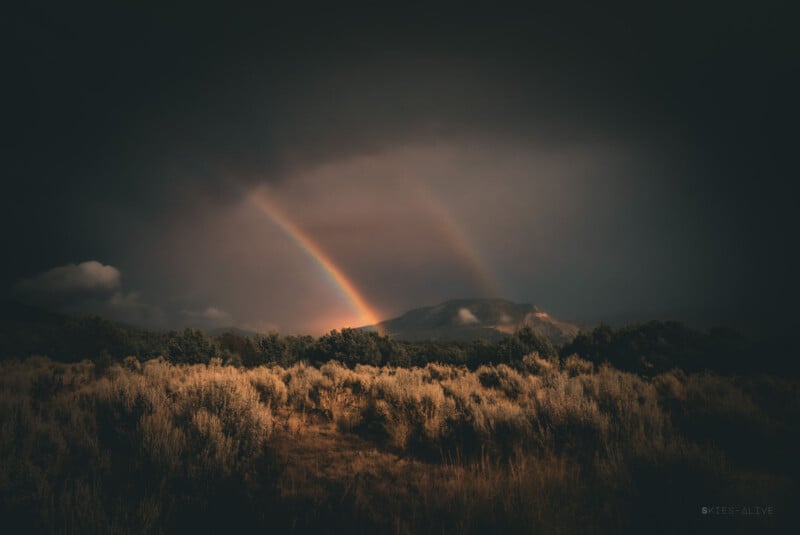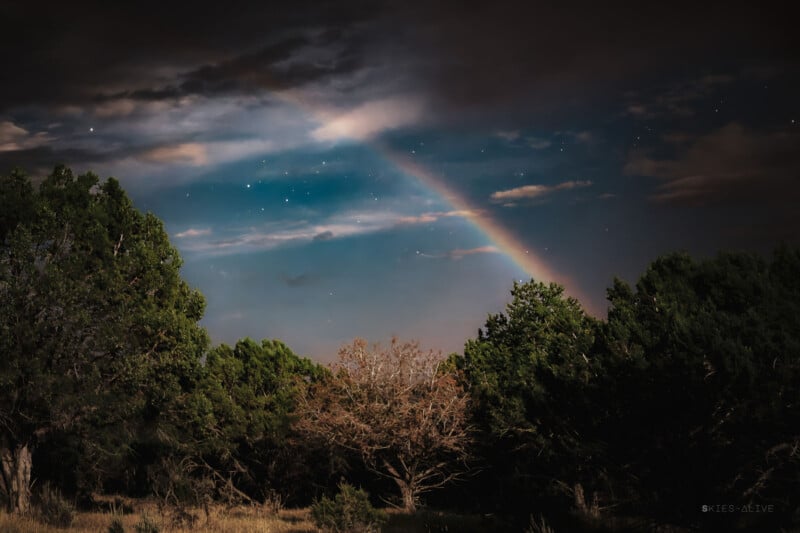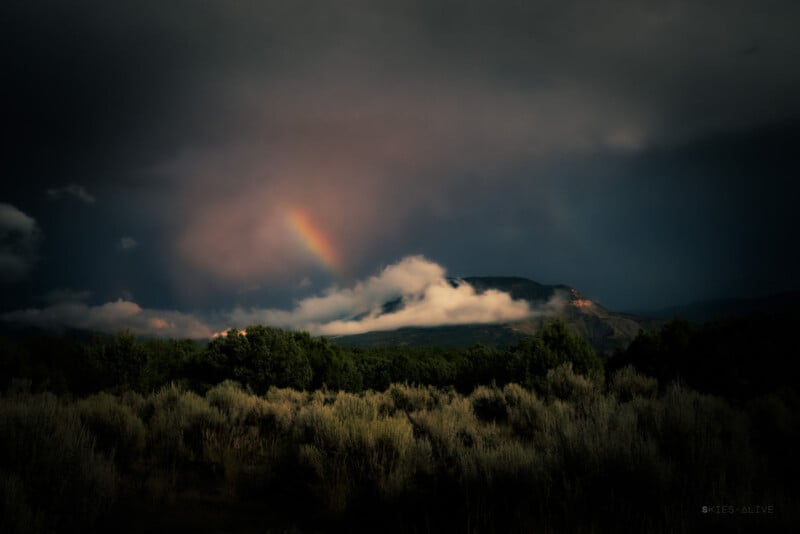Photographer Captures Beautiful and Rare Double ‘Moonbow’

Photographer Aaron Watson, who goes by Skies Alive Photography, has seen many incredible things in the night sky. His latest sighting is a rare double “moonbow,” a rainbow created by bright moonlight in precise conditions.
Colorado-based Watson was woken up to the sound of rain early in the morning last Sunday, August 18. Despite the rain, bright moonlight from a nearly full Moon was streaming through his window. Watson told Space that the conditions offered “the perfect recipe for a moonbow!”
Moonbows, or Moon rainbows, operate similarly to their more common and well-known daytime “rainbow” sibling. Much like when the Sun’s light is scattered by water droplets in the air, called refraction, to create a rainbow, a moonbow results from the Moon’s light being refracted by water.
However, while the mechanism is the same, the amount of light generated by the Sun and the Moon are dramatically different, which impacts the look and frequency of lunar rainbows.

“I’ve seen three moonbows in my entire life, all in the last year,” Watson tells PetaPixel. “I have been searching for them for at least a decade, but they had eluded me up until recently.”
All three have been similar in appearance and location, although Watson says a single lunar rainbow he saw in 2023 was probably the biggest, while the latest one, the double moonbow, started brighter than others before quickly fading.
“It was bright enough that I could see the colors with my unaided eye, something I hadn’t noticed in the first two previous moonbow sightings,” the photographer explains. “Each one has been awesome, just seeing that delicate white arc illuminated in the moonlight is a magical sight to witness.”

For the most recent sighting, Watson used his Nikon D750 DSLR with a Sigma 14-24mm f/2.8 Art lens. The exposure is four seconds at ISO 3,200, indicating just how bright the moonlight was last Sunday. He says his first shot, an eight-second exposure, was too bright, so he used a faster shutter speed.
“I could have played around with a lower ISO or upping the f-stop, but it was all happening so fast, and it looked pretty good at a four-second exposure, so I went with that.”
Although the colors were visible to Watson’s naked eye, he says that the photo is more vivid than real life was, much like when shooting auroras.
“To the naked eye, the moonbow looked like a white rainbow. It appeared exactly like a rainbow should look: as an arc across the sky, except at first glance it looked all white,” Watson explains. “Then after looking at it for a minute, I started to notice the bands that define the different colors, only instead of colors, it looked like various shades of white and gray, but in very clearly defined stripes. Then, after looking even longer, I could start to see the subtle colors with my unaided eyes. It took a while to tune in. I hadn’t noticed being able to see the colors until experiencing this most recent moonbow.”

Watson says he’s lucky to live where he can see such beautiful natural phenomena without traveling far. Light pollution is now, and he has a clear view of the sky.
“This was all luck though,” he admits. “I was happily sleeping to the gentle sound of falling rain when I happened to wake up with the Moon shining through my window. I groggily thought to myself, ‘Moon and rain?'”
“My mind was like, ‘Ding! Go outside and look for a moonbow!’ And sure enough, there it was.”
He shouted to wake up his partner, who Watson says is used to his passion for exciting night sky events, and she was able to see the beautiful lunar rainbow, too.
“I ran up the road through the mud to get a good shot,” Watson says, noting that his partner was able to stay in the comfort of their home to enjoy the sights.
For those who want to see a lunar rainbow for themselves, Watson says that they don’t seem to materialize when he plans for it. Isn’t that the way? But there are ways to improve one’s odds.

“You can increase your chances by looking for nights when the Moon is full or nearly full and rain is in the forecast. You never know what might happen!”
“I wonder how many times a moonbow appears but there’s nobody there to see it?” Watson adds.
He’s no stranger to chasing rare sights. He’s been actively searching for auroras lately and has seen a few displays in western Colorado this year. “I’m hoping for a few more,” he says.
Wow what an amazing night! Caught this display around 1:30 am. Its a panorama of 9 shots. The Aurora was going off!…
Posted by Skies Alive Photography on Monday, August 12, 2024
Watson is also looking ahead to October when there might be a bright comet in the sky that could be “fun to chase.”
“That is, if it survives its encounter with the Sun.”
“And who knows what else? Part of the fun is catching something totally unexpected,” Watson concludes.
More of Aaron Watson’s photography is available on his website, Skies Alive. He also regularly shares new photos on Instagram and Facebook.
Image credits: © Aaron Watson / Skies Alive Photography